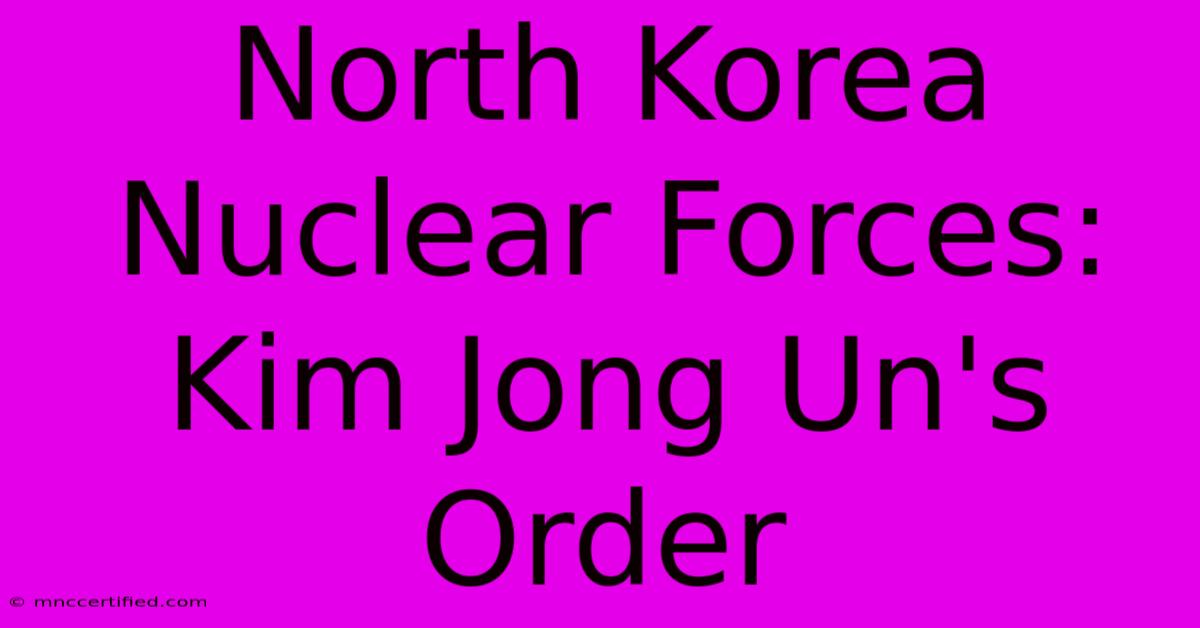North Korea Nuclear Forces: Kim Jong Un's Order

Table of Contents
North Korea's Nuclear Forces: Kim Jong Un's Order and the Global Implications
North Korea's nuclear weapons program, under the unwavering command of Kim Jong Un, presents one of the most pressing security challenges of the 21st century. Understanding the evolution, capabilities, and implications of these forces is crucial for navigating the complex geopolitical landscape of East Asia and beyond. This article delves into the intricacies of North Korea's nuclear arsenal, examining its development, the strategic rationale behind it, and the potential consequences for regional and global stability.
The Genesis of North Korea's Nuclear Ambitions
North Korea's pursuit of nuclear weapons is rooted in a complex interplay of factors, including a perceived need for security against external threats, particularly from the United States and its regional allies, South Korea and Japan. The Korean War's legacy, coupled with a history of perceived aggression and instability in the region, fueled the regime's determination to develop a nuclear deterrent. The Kim Jong-il era saw the initial clandestine development of nuclear capabilities, accelerating under his son and successor, Kim Jong Un.
The Kim Jong Un Era: Acceleration and Escalation
Kim Jong Un's ascension to power marked a significant escalation in North Korea's nuclear program. He oversaw a rapid increase in the number of nuclear tests conducted, showcasing a clear commitment to expanding the country's arsenal. This aggressive approach is intended to solidify North Korea's position on the global stage and leverage its nuclear capabilities for political and diplomatic leverage. The regime views its nuclear arsenal as a guarantor of its survival, a powerful tool against any perceived threat to its sovereignty.
Capabilities and Technological Advancements
North Korea's nuclear capabilities are constantly evolving. While precise details remain shrouded in secrecy, intelligence assessments suggest advancements in several key areas:
- Nuclear Weapon Miniaturization: Reports indicate significant progress in miniaturizing warheads, allowing for their deployment on ballistic missiles. This is a critical capability for effectively delivering a nuclear payload.
- Ballistic Missile Technology: North Korea has developed a range of ballistic missiles, with some capable of reaching targets across the Asia-Pacific region and potentially even the United States. The development of intercontinental ballistic missiles (ICBMs) represents a significant leap in its capabilities.
- Nuclear Testing: The numerous nuclear tests conducted by North Korea, despite international condemnation, have provided valuable data for refining its weapons design and increasing the yield of its warheads.
The Strategic Rationale Behind Kim Jong Un's Nuclear Order
Kim Jong Un's nuclear strategy isn't merely about possessing weapons; it's about using them as tools for achieving specific political objectives:
- Deterring foreign intervention: The primary aim is to dissuade external powers from military action against North Korea.
- Regional power projection: Nuclear weapons enhance North Korea's regional influence and standing, allowing it to negotiate from a position of strength.
- Regime survival: The nuclear arsenal serves as the ultimate guarantor of the Kim dynasty's continued rule, deterring any potential internal or external threats.
Global Implications and International Responses
North Korea's nuclear program poses a significant threat to international security and stability. The potential for miscalculation, accidental escalation, or proliferation to other states remains a serious concern. The international community has responded with various measures, including:
- United Nations Security Council Sanctions: Numerous sanctions have been imposed on North Korea to restrict its access to materials and technology crucial for its nuclear program. However, their effectiveness has been debated.
- Diplomacy and Negotiations: Repeated attempts at diplomatic engagement and negotiations have yielded mixed results, with periods of progress followed by setbacks.
- Military Deterrence: The United States and its allies maintain a significant military presence in the region, acting as a deterrent against North Korean aggression.
Conclusion: The Ongoing Challenge
North Korea's nuclear arsenal, firmly under Kim Jong Un's control, remains a persistent challenge to global security. Understanding the intricacies of its program, the regime's strategic motivations, and the broader geopolitical context is vital for developing effective strategies to manage this complex issue. The international community faces the ongoing task of balancing the need for effective deterrence with the pursuit of diplomatic solutions to prevent further escalation and ensure regional stability. The future trajectory of North Korea's nuclear program remains uncertain, demanding continued vigilance and careful consideration from all stakeholders.

Thank you for visiting our website wich cover about North Korea Nuclear Forces: Kim Jong Un's Order. We hope the information provided has been useful to you. Feel free to contact us if you have any questions or need further assistance. See you next time and dont miss to bookmark.
Featured Posts
-
Is Gum Graft Covered By Insurance
Nov 19, 2024
-
Lee Carsley Englands Youth Foundations Laid
Nov 19, 2024
-
Angelina Jolies 2024 Vintage Choice
Nov 19, 2024
-
Work From Home Pet Insurance Jobs
Nov 19, 2024
-
Farm Bureau Mobile Home Insurance
Nov 19, 2024